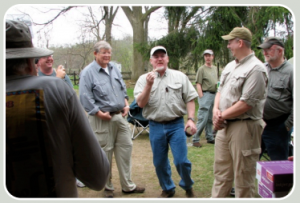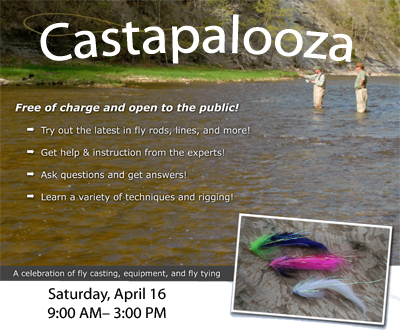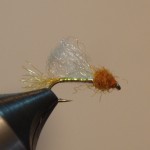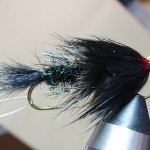 We are pleased to be featured on the Project Healing Waters website. First and foremost, we want to thank all of the active military service personnel and veterans that serve our country so valiantly. SJRVFF is proud to donate flies from our Tie-A-Thon to such a worthy organization. Project Healing Waters is dedicated to the physical and emotional rehabilitation of disabled active military service personnel and veterans through fly fishing and fly tying education and outings. For more information regarding their organization and the programs they offer, please visit http://www.projecthealingwaters.org/.
We are pleased to be featured on the Project Healing Waters website. First and foremost, we want to thank all of the active military service personnel and veterans that serve our country so valiantly. SJRVFF is proud to donate flies from our Tie-A-Thon to such a worthy organization. Project Healing Waters is dedicated to the physical and emotional rehabilitation of disabled active military service personnel and veterans through fly fishing and fly tying education and outings. For more information regarding their organization and the programs they offer, please visit http://www.projecthealingwaters.org/.
News and Updates
MAY 2011 MEETING
May 2011 SJRVFF Loop
Here is the May 2011 SJRVFF Loop…..you need it to be in the know.
Tight Lines!
Andy
Editor
Opening Day Outing
 The SJRVFF Opening Day Outing will take place on Saturday, April 30th at Bobbie LaBar’s farm on Dowagiac Creek. This is an all day event – there will be coffee & doughnuts for the early birds at 8:00 a.m., and lunch will be served at noon.Lunch will be provided by the club, along with water & soda. The club will not be providing beer or wine – you’ll have to bring your own. The drawing for Feenstra Guide Trip will take place at 1:30 p.m.
The SJRVFF Opening Day Outing will take place on Saturday, April 30th at Bobbie LaBar’s farm on Dowagiac Creek. This is an all day event – there will be coffee & doughnuts for the early birds at 8:00 a.m., and lunch will be served at noon.Lunch will be provided by the club, along with water & soda. The club will not be providing beer or wine – you’ll have to bring your own. The drawing for Feenstra Guide Trip will take place at 1:30 p.m.ECHO Donates Pole Saw to SJRVFF
Castapalooza Saturday, April 16
Jerry Darkes of Scott Rod Company will be at Leeper Park with a slew of rods to cast on the St. Joseph River. On the St. Joe River at Leeper Park in South Bend, Indiana 9:00am – 3:00pm.
- Ongoing Fly Casting Programs: Single, Switch and Two Hand Rods.
- Featuring regionally-known fly casting instructors and pro anglers Jeff Liskay, Jerry Darkes and guests.
- Fly tying demos by top local tiers.
- Displays by local retailers. Equipment from top manufacturers: Scientific Anglers, Scott Fly Rods, Nautilus Reels, Patagonia, Echo, Freedom Hawk Kayaks and more.

April 2011 SJRVFF Loop
Here is the SJRVFF Loop…..you need it to be in the know.
Tight Lines!
Andy
Editor
Next Meeting on the 6th floor – April 20, 2011
6:00 PM April 20th Annual Club Auction will be held on the 6th floor of the Chase Bank building (Same as the March Meeting- map). The money we raise is used to support the Clubʼs activities throughout the year, including the outings, fly tying classes, the stream improvements, the donations for stockings in our local waters and speakers.
BYOB
Due to a temporary technicality with its liquor license, The Cellar Door can no longer serve alcoholic beverages until further notice. Members of SJRVFF may bring in their own alcohol to consume. The Cellar Door regrets this and will inform us when the license is reinstated. As always, please drink responsibly.
Opal Iris Caddis – Eric Wroblewski

I sat down at my tying table one evening to whip up some of Dennis Potter’s Opal X Caddis for a upcoming fishing trip. I have used his Opal X Caddis pattern with great success on the Michigan and Montana streams I fish, for the past several years. When I was done I decided to try tying some Amber Iris Caddis. I had just recently purchased Craig Matthew’s and John Juracek’s “Fly Patterns of Yellowstone “ Volume 2 book, along with a sample Iris Caddis and some of their Amber Zelon dubbing. I tied several Iris Caddis per the instructions in the book, and laid them on my tying table next to the Opal X Caddis that I tied earlier. Looking at the two patterns sitting next to each other gave me the idea for the Opal Iris Caddis. I tied a few up and tried them on my area stream a few days later. The brown trout residing there gave the Opal Iris Caddis a big thumbs up!
(Click on photo to see a full size photo)
[line]
Material List
Hook: Tiemco 100 – Size #16
Thread: UTC 70D Burnt Orange
Shuck: Amber Zelon
Body: UTC Mirage Opal Tinsel (medium)
Wing: White Zelon or White EP Fibers
Head: Amber Zelon Dubbing
[line]
Tying Instructions
Tie in the amber zelon shuck about 1/3 hook shank length behind the hook eye. Wrap thread back to the bend of the hook binding down the zelon shuck, and back up to the tie in point. Trim shuck to about 1/3 hook shank length.
Tie in a length of opal tinsel at the tie in point and half hitch. Wrap opal tinsel back to hook bend and then back up to the tie in point. Bind down well, trim tinsel and half hitch. Using a rotary vise makes this step very fast and efficient. Just make sure you take care when getting close to the hook point – it will cut the tinsel and force you to start over if you are not careful!
Take a short piece of white zelon or EP fibers and fold to make a loop. Tie in the wing on the top of the hook so the loop extends to the end of the hook shank. Bind the wing down with several tight wraps and half hitch. Trim the butt fibers close and at a 45 degree angle from the hook eye.
Dub some amber zelon dubbing on your thread and dub a shaggy head covering the wing tie in. Leave enough room for a small thread head, and whip finish. The dubbed head should be kinda fat from the bulk of the wing tie in, and that is how you want it to look.
[line]
- Zelon Dubbing is available from Blue Ribbon Flies, West Yellowstone, MT
- Instead of Zelon Dubbing, any coarse or shaggy dubbing can be used
- I use size medium Opal Tinsel for #14 & #16, size small Opal Tinsel for #18 & #20
[line]
Doctor J – Eric Wroblewski

This is a Bear Andrews pattern that I learned to tie at his tying class last spring. His claims to it’s effectiveness convinced me to tie them up to use for last year’s steelhead run and I had good success with it. It is a bead head wiggle-nymph pattern and I tied them in black with orange, chartruese, and pink bead heads. Tie some up for the upcoming run and give them a try!
(Click on photo to see a full size photo)
[line]
Trailer Hook: TMC #3761 size 8 – 4
Front Hook: TMC 105 size 8 – 4
Thread: 8/0 or 70D thread to match body
Trailer Hook Body Tail: Pheasant rump feather marabou or Squirrel strip fur to match body color
Body: Black dubbing brush or Ice Dub
Hackle: Pheasant rump feather to match the body color
Collar: Pheasant rump aftershaft feather
Front Hook Body: Bead Head: 5/32 bead – orange, Chartruese, or pink
Hook Joint: 15 pound mono
Fur Head: Pine squirrel strip to match body
[line]
Tie the trailing body first. Tie in the tail of Pheasant rump feather marabou or a pinch of pine squirrel fur. Wrap a body from a dubbing brush or dub one using Ice Dub dubbing. Then tie in a pheasant feather by the tip and wrap 3 -4 times. Finally tie in the aftershaft feather and wrap to make a fluffy collar. You have tied a sparrow nymph. Now slide the bead on the front hook and tie in a piece of mono behind the bead. Bind down well, slide the trail fly on the mono, form a loop and bind down the mono again with thread. Tie in the squirrel strip at the bend of the hook and coat the thread with Fishermans glue or superglue. Wrap the squirrel strip to the bead, bind down well and whip finish.

